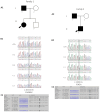Two Novel Variants in the CHRNA2 and SCN2A Genes in Italian Patients with Febrile Seizures
- PMID: 39596607
- PMCID: PMC11593345
- DOI: 10.3390/genes15111407
Two Novel Variants in the CHRNA2 and SCN2A Genes in Italian Patients with Febrile Seizures
Abstract
Background: Febrile seizures (FSs) are the most common form of epilepsy in children aged between six months and five years. The exact cause is unknown, but several studies have demonstrated the importance of genetic predisposition, with increasing involvement of receptors and ion channels. The present study aims to identify novel pathogenic variants in Italian patients with FSs.
Methods: We performed targeted panel sequencing in a cohort of 21 patients with FSs. In silico analysis was performed to predict the pathogenic role of the resulting variants.
Results: We found two novel variants segregating in two families with FSs: c.1021C>G (p.Leu341Val) in the CHRNA2 gene and c.140A>G (p.Glu47Gly) in SCN2A.
Conclusions: The c.1021C>G (p.Leu341Val) variant leads to a codon change of highly conserved leucine to valine at position 341 and is located in segments M3 of the subunit, which is important for channel gating. The c.140A>G (p.Glu47Gly) variant causes a substitution of glutamic acid with glycine at position 47 of the protein, which is highly conserved across the species. Moreover, it is located in the N-terminal domain, a region commonly affected in ASD, which impacts the inactivation kinetics and voltage dependence of steady-state activation. Further analyses are needed to better explain the role of CHRNA2 and SCN2A in the development of febrile seizures.
Keywords: CHRNA2; SCN2A; febrile seizures; nicotinic acetylcholine receptor (nAChR); voltage-gated sodium channel (Nav) 1.2.
Conflict of interest statement
The authors declare no conflicts of interest.
Figures


References
MeSH terms
Substances
Grants and funding
LinkOut - more resources
Full Text Sources

